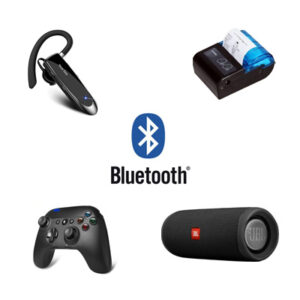Bluetooth problems in Windows computers are often related to incorrect or missing drivers for a Bluetooth device. In the case of the Broadcom BCM20702A0 device, the right BCM20702A0 driver is required for the device to function in Windows. Otherwise, the device will not work and show an error. Any other Bluetooth devices depending on the BCM20702A0 device will most likely also not work or not be recognized.
What is BCM20702A0?
BCM20702A0 refers to a Broadcom Bluetooth 4.0 chip. It is often used in USB Bluetooth dongles, but can also be embedded directly in a computer (laptop, desktop, or all-in-one PC). The chip implements Bluetooth communication which allows a Windows-based PC with this device to connect to external, wireless devices that support Bluetooth. Examples are headsets, game controllers, printers, mice, mobile phones, and similar.

Since the BCM20702A0 chip is used on hardware solutions from different manufacturers, a driver specific to the manufacturer may be required to ensure the BCM20702A0 device is recognized by Windows. Dell, Lenovo, Asus, and others all have drivers available for hardware using the Broadcom BCM20702A0 chip.
BCM20702A0 Related Problems
If the BCM20702A0 driver is not installed, or not compatible with the installed device or Windows version, there will be an error. In the Windows Device Manager, the device will be listed under the Other devices category. An exclamation mark on the device icon indicates it is not working properly.
The possible error message for not working Bluetooth devices in Windows:
- This device cannot start. (Code 10)

- The drivers for this device are not installed. (Code 28)
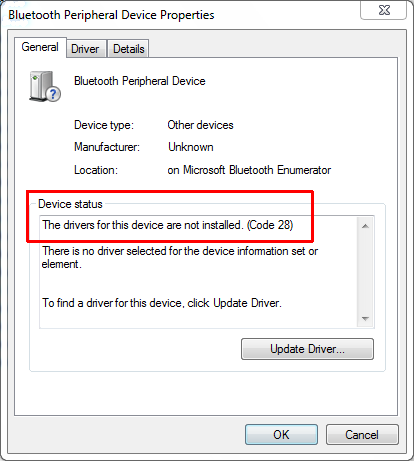
In Windows 10 and Windows 11, the message will say “There are no compatible drivers for this device”. Instead of “There is no driver selected for the device information set or element”. - This device is not working properly because Windows cannot load the drivers required for this device. (Code 31)
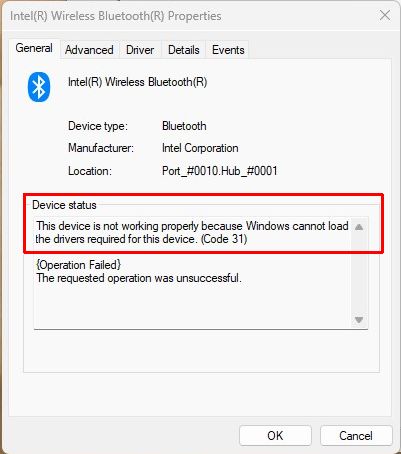
In normal circumstances, all working Bluetooth devices will show in the Bluetooth category in the Device Manager. But if the right driver is not installed, this category might not show at all.
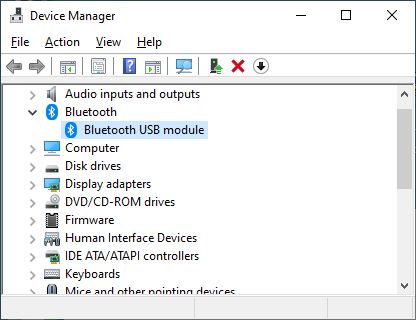
The result of a non-working Bluetooth module is that Windows will not be able to connect to any Bluetooth devices. Pairing with Bluetooth devices will be impossible.
Steps to solve BCM20702A0 problems in Windows
The most common cause of the problems related to the BCM20702A0 device is a driver problem. So, in solving the error, the first steps are focused on getting the right driver installed. If after that, the device still does not work, try the other methods to fix the issue.
Before starting with the steps, make sure that the Bluetooth USB dongle is plugged (in case an external Bluetooth solution is used). Trying to solve the Bluetooth problem without the device physically present in the computer will not work. This sounds silly but it is better to check than wasting time trying to fix a non-issue. Also, make sure you reboot your computer. Pending restarts after updates can be the source of problems.
Update the BCM20702A0 driver from the Device Manager
The Device Manager is the most common method to install and update drivers for devices in all Windows versions. So, try these steps to update the driver.
- Press the Windows + R keys to open the Run dialog box.
- Type devmgmt.msc in the Run box and press Enter or click OK. This will open the Device Manager.
- In the Device Manager window, locate the problematic Bluetooth device in either the Other devices category or the Bluetooth category.
- Right-click the BCM20702A0 device and in the popup menu, select Update Driver Software (Update driver in Windows 10 and Windows 11).
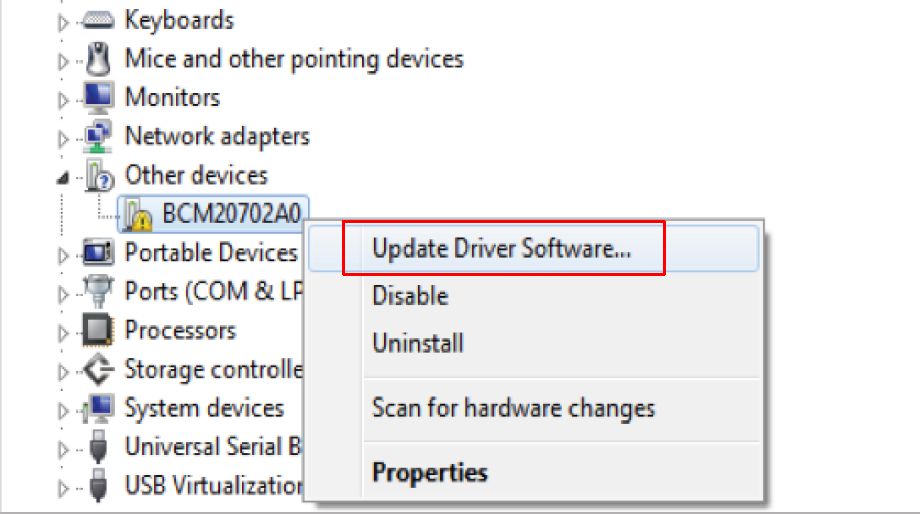
- Use the Search automatically for drivers option to let Windows find the correct driver for the device. Click Close when the driver has been installed.
In case Windows does find a driver for the device, a driver will need to be manually downloaded from the manufacturer’s website.
Manually download the BCM20702A0 driver
If Microsoft has not included a driver for the BCM20702A0 device in the version of Windows that you are running, a driver will need to be added manually. This means a Bluetooth interface driver needs to be downloaded from the manufacturer’s website. Check your computer brand and model and locate the manufacturer’s support website to search for the driver.
Note: Broadcom used to support their own version of the Bluetooth software, including drivers. This generic WIDCOMM Bluetooth Software is no longer maintained and supported.
Once downloaded, run the setup or install program for the driver package to install the driver in Windows. Note that a user account with administrator privileges is required to install drivers.
If a driver is not available for your Windows version, you can try running an driver for an older Windows version in compatibility mode. For example, say we are running Windows 10, but the Dell installer for the Bluetooth module is suited only for Windows 7. If there is no Windows 10 driver available, we run the Windows 7 installer as follows:
- Right-click the downloaded installer file.
- In the popup menu, select Properties.
- In the file properties dialog box, select the Compatibility tab.
- Under Compatibility mode, select the checkbox for Run this program in compatibility mode for (1), and select Windows 7 in the dropdown box (2).
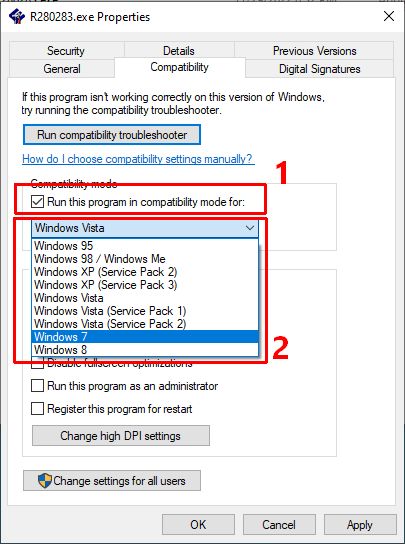
- Click OK to confirm and close the properties dialog box.
- Now execute the driver installer again.
Important: The driver needs to match the Windows architecture in order to work. Installing a 32-bit driver on a 64-bit system will not work, even in compatibility mode.
If the downloaded driver package does not have a setup or install program, you need to manually install the driver using the Device Manager.
Update drivers using Microsoft Update
Microsoft has included support for many devices in every updated version of Windows. Although that means that many devices are detected and supported directly, some devices require optional updates. In Windows 10 and Windows 11, optional updates often include updated drivers for devices. To check if the Broadcom BCM20702A0 driver is available, follow these steps.
- Open the Settings windows from the Start menu.
- In the Settings window, select Windows Update.
- In Windows 11, click Advanced options (skip this step in Windows 10).
- Next, click View optional updates.
- Under Optional updates, click the Driver updates entry to expand the list and see the available driver updates.
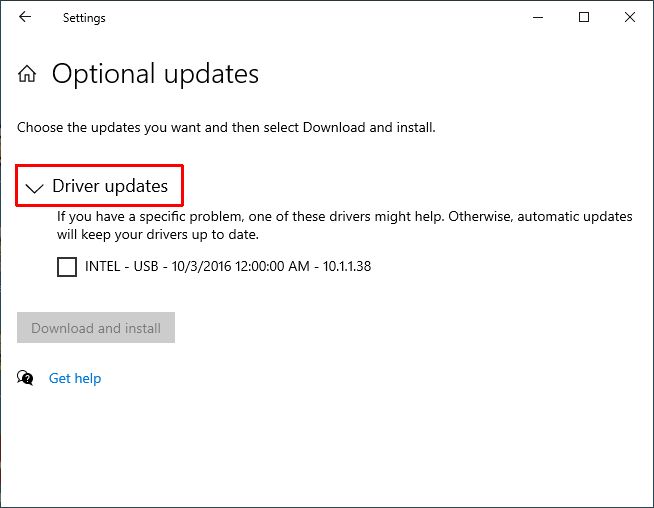
- If there is an entry for the BCM20702A0 driver, select it and click the Download and install button.
If no driver update is available for the Bluetooth device, the BCM20702A0 device is not supported in Windows. At least not by Microsoft directly. You will need to use the steps to manually download the driver to get it to work.
Restart the Bluetooth Services
This is the first of the steps that do not directly relate to the BCM20702A0 driver. Even if the driver is installed, the device can still give an error. The error might be solved by one of the following solutions.
Windows uses several services (background tasks) for making sure the Bluetooth devices and functions can work. In some cases, a service may have a problem, and manually starting or restarting the service can fix the problem.
Here are the steps to restart the Bluetooth services in Windows.
- Press the Windows + R keys to open the Run dialog box.
- Type services.msc in the Run box and press Enter or click OK. This will open the Services window.
- In the Services window, locate the Bluetooth Support Service and right-click it.
- In the popup menu, click Restart.
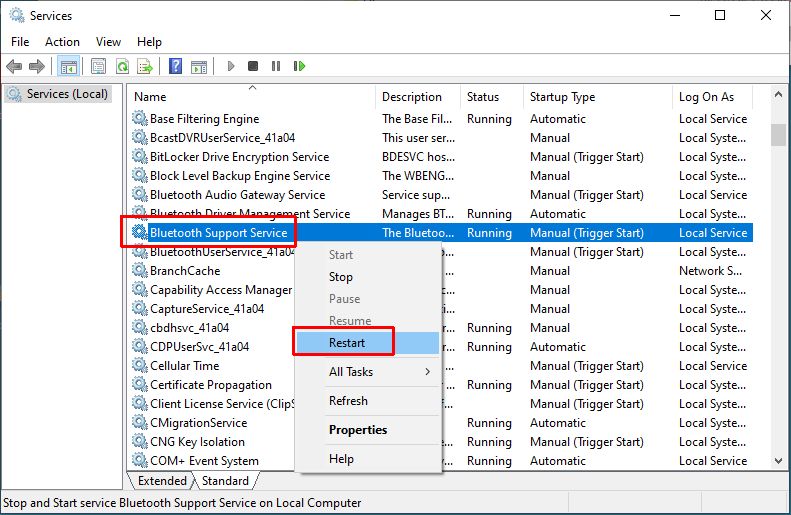
- Close the Services window when done.
You can repeat these steps for other Bluetooth services, like the Bluetooth Driver Management Service. If the services are not in a Running state, simply try starting them instead of restarting them. Not all Bluetooth services need to be running for the BCM20702A0 device to be detected and installed. Some are for support tasks, like audio over Bluetooth. But starting or restarting them manually ensures that they are not the reason the device is not working.
Run the Bluetooth troubleshooter
In Windows 10 and Windows 11, there is the possibility to run a Windows troubleshooter for a number of problems. Microsoft has included a troubleshooter function for common problems that can be automatically solved. One such troubleshooter is the Bluetooth troubleshooter.
To execute the Bluetooth troubleshooter in Windows 10, follow these steps.
- Open the Settings window from the Start menu.
- In the Settings window, select Update & security.
- Next, click Troubleshoot in the left-hand pane.
- In the right-hand pane, click the Additional troubleshooters link.
- Next, under Find and fix other problems, click the Bluetooth option.
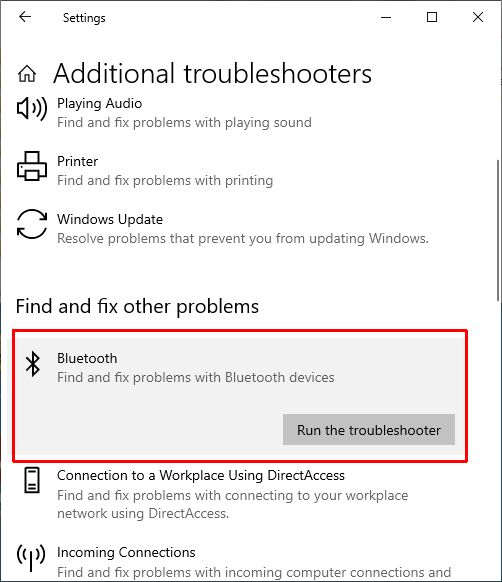
- This will show the button Run the troubleshooter. Click it to start the troubleshooter.
- A new window will come up showing Windows is Detecting problems with Bluetooth. Wait for the process to finish analyzing and fixing any Bluetooth-related issues.
- Click Close when done.
In Windows 11, the steps are a little different.
- Open the Settings window from the Start menu (or press the Windows + I keys).
- In the Settings window, click System.
- Next, click Troubleshoot in the right-hand pane.
- Click the Other troubleshooters link.
- Click the Run button next to Bluetooth under Other.

- Wait for the troubleshooter to finish analyzing and fixing any Bluetooth-related problems.
Note: The Bluetooth troubleshooter can take considerable time to complete.
Check the Airplane mode setting
This is mentioned as one of the last solutions since the option would normally only be used on portable devices for a specific reason. But if you have been traveling with your laptop, it is a step that is worth taking.
Personally, I simply disable the Bluetooth option in Windows and only enable it when needed. Active communication on any device is a security risk these days. But if you have Bluetooth turned in normal circumstances, you can opt to use the Airplane mode in Windows to disable all communication when traveling.
In both Windows 10 and Windows 11, the Airplane mode can be enabled or disabled by clicking the network icon in the taskbar and selecting the Airplane mode in the quick access popup window.
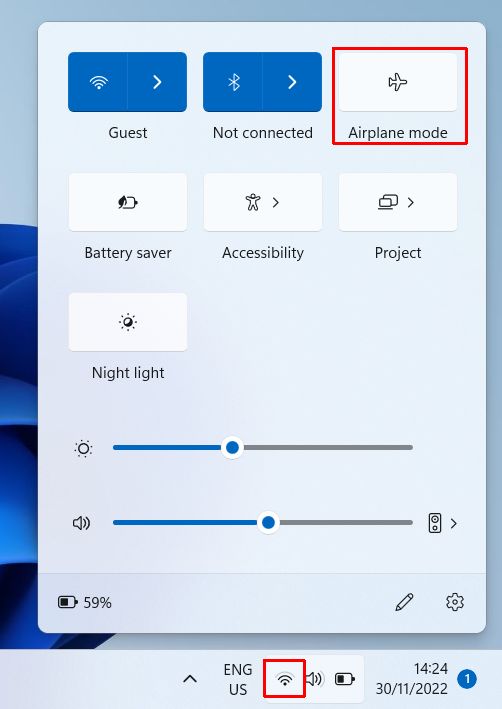
Note that the Airplane mode will show active when enabled (blue in this example but that will depend on the active Windows theme). Airplane mode should be disabled for Bluetooth to work.
If you prefer to use the Windows Settings, follow these steps.
- Open the Settings window from the Start menu.
- In the Settings window, click the Network & internet option.
- Next, click the Airplane mode option.
- Now make sure both switches are in the Off position.
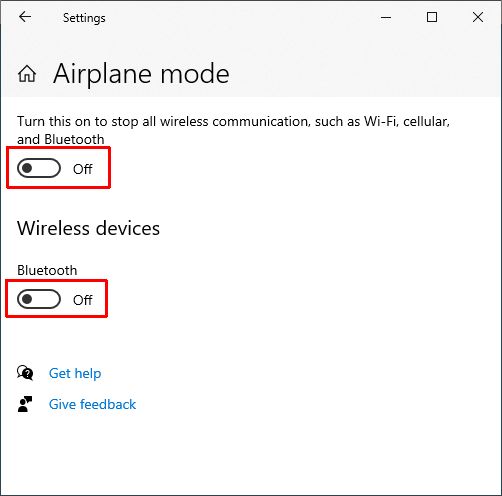
In Windows 11, you have the option to disable the Airplane mode directly, or like in Windows 10, select the Airplane mode option to control the individual settings.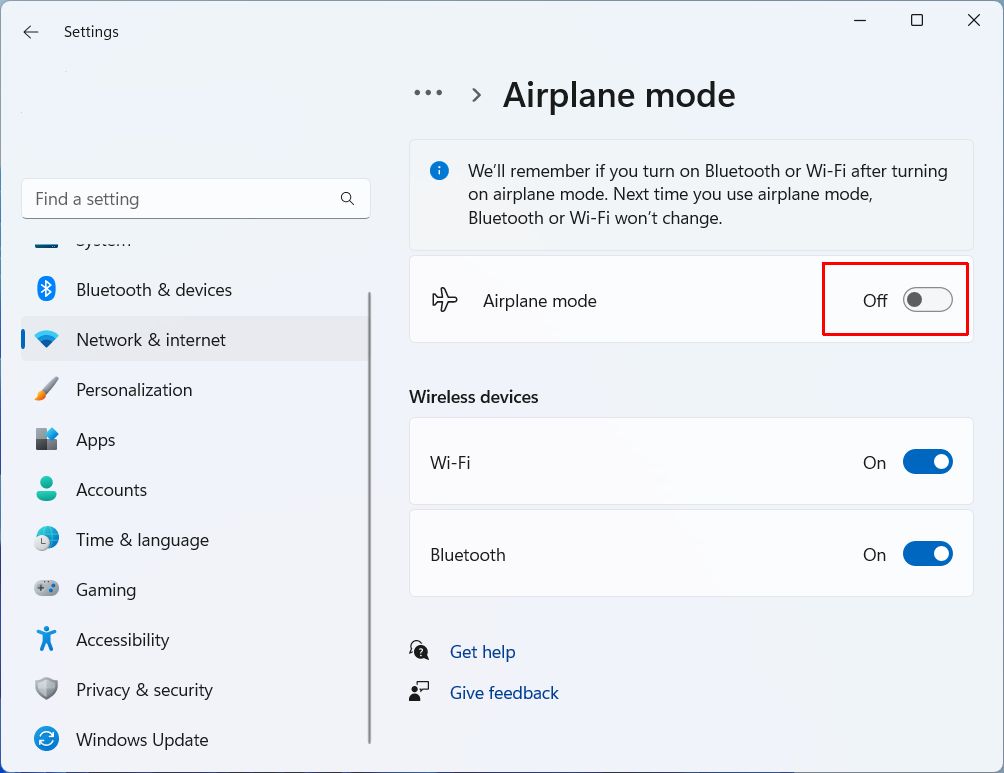
Windows 11 remembers which communication was on when you enable and disable Airplane mode. So, if only Wi-Fi was on and Bluetooth was off when airplane mode was activated, Bluetooth would remain off when airplane mode is disabled again. This is why it is a good idea to check this setting. - Close the Settings window when done.
After this, the network and Bluetooth devices should be working. There is no need to restart the computer, the changes take effect immediately.
Reset the hardware devices
Windows keeps configuration information for all devices in the computer. In rare cases, the configuration of a device can be a problem. Installing similar devices with similar drivers, or installing additional USB devices on the same controller can result in a BCM20702A0-based device to stop working.
To fix the issue, it is possible to reset the device by removing it and letting Windows reinstall the device with the proper configuration settings. These steps need to be executed from within the Device Manager.
Follow the steps to update the BCM20702A0 driver from the Device Manager, but instead of picking the Update driver option, select the Uninstall option. In the Uninstall Device confirmation window, click the Uninstall button (1). This will remove the device from Windows. After this reboot to let Windows automatically detect and reinstall the device.
First, try the uninstall option and keep the drivers installed. If that does not fix the issue, use the option Delete the driver software for this device when uninstalling it (2). That will force Windows to reload the driver for the Bluetooth device.
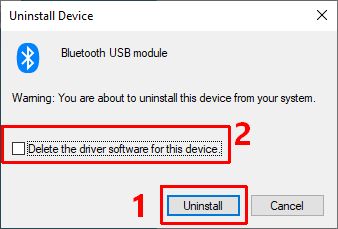
If the BCM20702A0 device is a USB dongle, it can also help to uninstall the USB Host Controllers in the Universal Serial Bus controller category. These controllers ensure that all connected USB devices are detected are installed. Resetting them can solve problems caused by the USB interface itself.
If things are still not working after this, then you might still be able to get things working again. That partly depends on whether the BCM20702A0 device was working on your system previously. If it was, a system restore or system recovery can bring back the working BCM20702A0 driver.
For help in finding the right drivers for your Windows devices, including the BCM20702A0 device, you can use the DriverFinder program. By scanning the hardware present, it will locate and offer the required device drivers.

